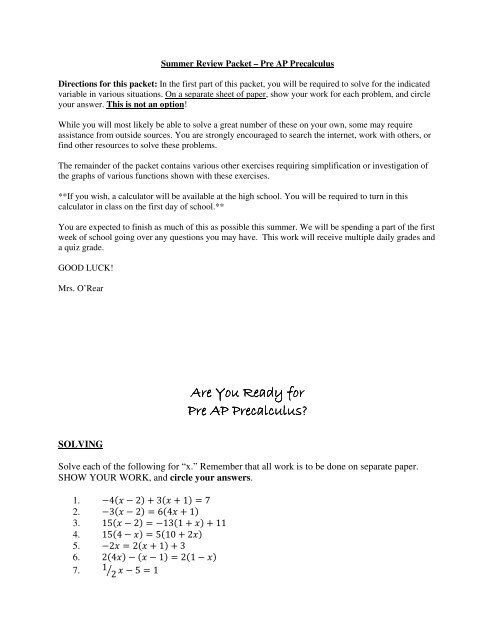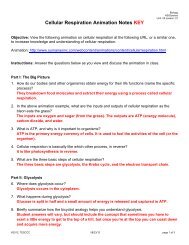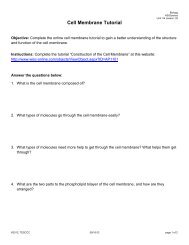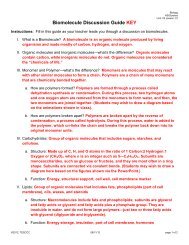Pre AP Precalculus?
Pre AP Precalculus?
Pre AP Precalculus?
Create successful ePaper yourself
Turn your PDF publications into a flip-book with our unique Google optimized e-Paper software.
Summer Review Packet – <strong>Pre</strong> <strong>AP</strong> <strong>Pre</strong>calculus<br />
Directions for this packet: In the first part of this packet, you will be required to solve for the indicated<br />
variable in various situations. On a separate sheet of paper, show your work for each problem, and circle<br />
your answer. This is not an option!<br />
While you will most likely be able to solve a great number of these on your own, some may require<br />
assistance from outside sources. You are strongly encouraged to search the internet, work with others, or<br />
find other resources to solve these problems.<br />
The remainder of the packet contains various other exercises requiring simplification or investigation of<br />
the graphs of various functions shown with these exercises.<br />
**If you wish, a calculator will be available at the high school. You will be required to turn in this<br />
calculator in class on the first day of school.**<br />
You are expected to finish as much of this as possible this summer. We will be spending a part of the first<br />
week of school going over any questions you may have. This work will receive multiple daily grades and<br />
a quiz grade.<br />
GOOD LUCK!<br />
Mrs. O’Rear<br />
Are You Ready for<br />
<strong>Pre</strong> <strong>AP</strong> <strong>Pre</strong>calculus?<br />
SOLVING<br />
Solve each of the following for “x.” Remember that all work is to be done on separate paper.<br />
SHOW YOUR WORK, and circle your answers.<br />
1. −4 − 2 + 3 + 1 = 7<br />
2. −3 − 2 = 64 + 1<br />
3. 15 − 2 = −131 + + 11<br />
4. 154 − = 510 + 2<br />
5. −2 = 2 + 1 + 3<br />
6. 24 − − 1 = 21 − <br />
7. 1 2<br />
− 5 = 1
8. 6 = 2 <br />
3<br />
5 − 2<br />
9.<br />
<br />
= <br />
<br />
10. |4 − 1| = 11<br />
Solve each for the indicated variable.<br />
11. Solve for r: = 2h<br />
12. Solve for w: = h<br />
13. Solve for w: = 2 + 2<br />
14. Solve for t: = + <br />
15. Solve for b: = <br />
16. Solve for h: = h<br />
17. Solve for x: = 12 − <br />
<br />
18. Solve for r: = 4 <br />
FRACTION REVIEW<br />
Simplify each of the following by:<br />
a) Addition or subtraction. Remember the rules for adding or subtracting fractions. If you<br />
don’t remember the rules, look them up!<br />
19.<br />
20.<br />
21.<br />
22.<br />
23.<br />
24.<br />
25.<br />
26.<br />
<br />
+ <br />
<br />
+ 4<br />
<br />
− <br />
<br />
− <br />
<br />
− <br />
<br />
+ <br />
<br />
<br />
− <br />
<br />
<br />
+
) Multiplication or division. Again, remember the rules for multiplying and dividing<br />
fractions. Look the rules up if you don’t remember them!<br />
27.<br />
28.<br />
29.<br />
30.<br />
31.<br />
32.<br />
33.<br />
34.<br />
35.<br />
36.<br />
37.<br />
38.<br />
<br />
∙ <br />
<br />
∙ 4<br />
<br />
<br />
∙ <br />
<br />
<br />
∙ <br />
<br />
<br />
÷ 4<br />
<br />
÷ <br />
⁄<br />
<br />
⁄<br />
<br />
<br />
⁄<br />
<br />
⁄<br />
<br />
<br />
⁄<br />
<br />
⁄<br />
<br />
<br />
⁄<br />
<br />
<br />
<br />
<br />
<br />
c) Answer questions a. – c. regarding each of the following functions.<br />
39. = <br />
<br />
a. Is the point (3, 14) on the graph of f?<br />
b. If x = 4, what is f(x)? What point is on the graph of f?<br />
c. If f(x) = 2, what is x?<br />
40. =
a. Is the point (-1, 1) on the graph of f ?<br />
b. If x = 2, what is ?<br />
c. If = 1, what is x?<br />
41. = <br />
<br />
a. Is the point (1, 3/5) on the graph of f ?<br />
b. If x = 0, what is ?<br />
c. If = , what is x?<br />
<br />
42. = <br />
<br />
QUADRATICS<br />
a. Is the point 1 2<br />
, −2 <br />
3<br />
on the graph of f ?<br />
b. If x = 4, what is ?<br />
c. If = 1, what is x?<br />
Solve each of the following by factoring.<br />
43. − 10 = 24<br />
44. 4 − 9 = 0<br />
45. 9 − 7 = 0<br />
46. 30 − 2 = −4<br />
Simplify each of the following. Remember: = √−1, and = −1.<br />
47. 6 + √−49<br />
48. 8 <br />
49. 5 + 7 + 4<br />
50. 3 − 8 − 2 + <br />
51. 6 + 4 − 9 − 4
52. 2 − 9 + 4 + 9<br />
53. 4 + 31 − 7<br />
54. 9 + 5 <br />
55. 2 + 52 − 5<br />
56.<br />
57.<br />
<br />
<br />
<br />
<br />
Solve by using the quadratic formula:<br />
58. 2 + 5 − 7 = 0<br />
59. + 6 − 5 = 0<br />
60. 2 + 8 = −12<br />
61. 3 = −4 − 10<br />
Evaluate the discriminant of each equation. Determine how many solutions and whether they are<br />
real or imaginary.<br />
62. + 4 + 5 = 0<br />
63. 2 + 7 − 15 = 0<br />
64. 4 + 20 + 25 = 0<br />
Write each quadratic equation in standard (vertex-intercept) form by completing the square.<br />
Then graph.<br />
65. = − 4 + 6<br />
66. = −2 + 12 − 15<br />
Write a quadratic equation for each pair of roots.<br />
67. -6 and -9
68. -1 and 3/2<br />
69. 4 (double root)<br />
POLYNOMIALS<br />
Simplify by using the indicated operations. Write each answer in descending order of exponents.<br />
70. −8 − 7 + − − 6<br />
71. 30 − 49 + 7 + 50 − 75 − 60 <br />
72. 5 − 6 + 8 − 3 − 9<br />
73. −3 + 7 − 8 − −5 + 9 − 8 + 19<br />
74. 5 6 − 2<br />
75. + 1 <br />
76. 2 − 32 + 42 − 1<br />
Factor each of the polynomials completely.<br />
77. + 64<br />
78. + 3 + 2<br />
79. 3 − 12<br />
80. 2 − 5 − 12<br />
81. + 3 − 4 − 12<br />
82. 125 − 27<br />
83. 6 − 48<br />
84. 3 − 5 + 6 − 15<br />
Divide using long division.
85. 9 − 18 − + 2 ÷ 3 + 1<br />
86. 3 − 5 + 1 ÷ + 9<br />
Divide using synthetic division.<br />
87. 6 − 4 + 14 − 8 ÷ + 2<br />
88. + 3 + + 4 ÷ + 3<br />
89. 3 − 5 + 2 + 3 − 2 ÷ 3 − 2<br />
For each of the following: a) list all possible rational zeros; and b) find all actual rational roots.<br />
90. + 4 + − 6 = 0<br />
91. 2 − 5 − 17 + 41 − 21 = 0<br />
LINEAR FUNCTIONS<br />
Graph:<br />
92. = −3 + 7<br />
93. = −<br />
94. = 5<br />
95. 3 − 2 = 6<br />
96. = −2<br />
97. = 3 <br />
5<br />
− 4<br />
98. 2 + 5 = −5<br />
99. 3 − 4 = 10<br />
Find the slope of each line containing the following pairs of points.<br />
100. (3, -2) (-5, -6)
(2, 3) (2.5, 3) (3.9,2.8) (4.2, 2.8)<br />
101. (1, 7) (3, 4)<br />
102. (2, 5) (2, 9)<br />
103. (1, 8) (-3, 8)<br />
104. , , <br />
Determine whether the lines containing the following pairs of points are parallel, perpendicular,<br />
or neither.<br />
105. Line 1: (4, 3) (1, 2) Line 2: (2, 5) (4, 11)<br />
106. Line 1: (3, 7) (-1, 6) Lines 2: (5, -5) (4, -9)<br />
Find the equation of the line with the given slope and containing the given point.<br />
107. = 1 <br />
2<br />
, (4, 5)<br />
108. = −2 <br />
3<br />
, (1, 1)<br />
Find the equation of the line containing the two given points.<br />
109. (4, 5) (7, 3)<br />
110. (-3, 2) (5, 2)<br />
111. (1, 9) (1, 4)<br />
Find the midpoint of the segment with the given endpoints; then find the distance between the<br />
two given points.<br />
112. (-4, 3) (2, 4)<br />
113. (5, -1) (9, 2)<br />
The following is a graph that represents the distance d (in miles) that Kevin is from home as a<br />
function of time t (in hours). Answer questions 114-122 based on the graph.
114. How many times did Kevin return home?<br />
Describe Kevin’s distance from home:<br />
115. from t = 0 to t = 2<br />
116. from t = 2 to t = 2.5<br />
117. from t = 2.5 to t = 2.8<br />
118. from t = 2.8 to t = 3<br />
119. from t = 3 to t = 3.9<br />
120. from t = 3.9 to t = 4.2<br />
121. from t = 4.2 to t = 5.8<br />
122. What is the farthest distance that Kevin is from home?<br />
The following is a graph that represents the speed v (in miles per hour) of Michael as a function<br />
of time t (in minutes).
(7, 50) (7.4, 50)<br />
(2, 30) (4, 30)<br />
(7.6, 38)<br />
(8, 38)<br />
(4.2, 0) (6, 0)<br />
(9.1, 0)<br />
t<br />
123. Over what interval of time is Michael traveling fastest?<br />
124. Over what interval(s) of time is Michael’s speed zero?<br />
125. What is happening to Michael’s speed between 0 and 2 minutes?<br />
126. Describe Michael’s speed between 7 and 7.4 minutes.<br />
127. How does the answer in #126 compare to that of #124?<br />
128. During what interval(s) is Michael’s speed constant?








